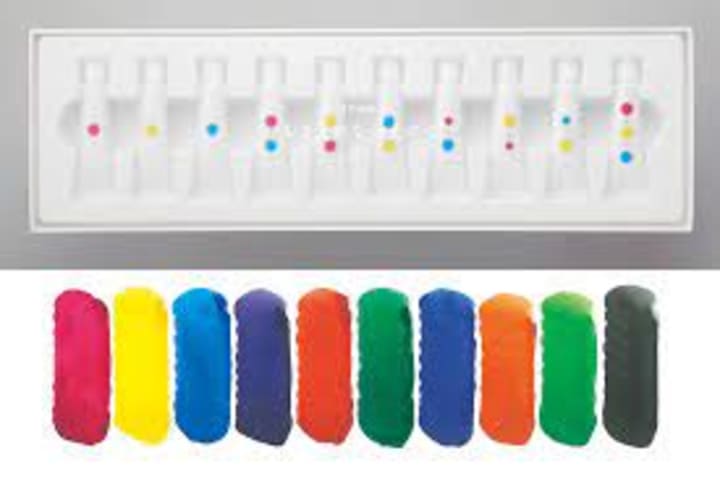Japanese Methodology
Inducing creativity in children

The Japanese people are renowned for their exceptional intellect, impeccable manners, and overall well-being. What sets this nation apart from the rest of the world? The answer lies in their distinctive and unparalleled education system, which employs innovative teaching methods. One such method, known as "Nameless Paints", is particularly noteworthy for its ability to foster creativity in children. Developed by Japanese designers Yusuke Imai and Ayami Moteki, this extraordinary paint set serves as a tool for teaching children about colors and painting. Its ingenuity was recognized when it received the prestigious "2012 Koyuko Design Award". Let us delve into the workings of this remarkable creation.

"Nameless Paints" revolutionizes the conventional approach to color identification by eschewing traditional color names in favor of abstract spots of varying sizes on each tube. This innovative design aims to transform children's thinking and learning processes, fostering an understanding of color mixing. For instance, a child encountering a tube adorned with pink and blue spots must experiment by squeezing it, ultimately discovering that equal amounts of pink and blue yield a vibrant purple hue. Consider this illustration: a tube featuring a conspicuous blue spot alongside a diminutive pink one. This signifies that by blending a minute quantity of pink with a substantial amount of blue, a deep blue hue is achieved.
Fascinating isn't it? Evidently, concealed within each tube lies a distinct hue: pink, yellow, blue, purple, red, dark green, dark blue, orange, light green, and black. Yet, to obtain any of these shades, the child must contemplate the amalgamation of colors that engender it. Consequently, they acquire knowledge of color synthesis and blending, making it a simple and enjoyable approach to comprehending the principles of color theory.
Recent research indicates that free-thinking can be cultivated and schools are crucial in fostering creativity. The Japanese education system encompasses remarkable attributes that warrant global adoption. The key to Japan's cultural triumph lies in its unwavering commitment to crafting an educational framework that is not only utilitarian but also imbued with an element of enjoyment.
1. In Japanese schools, the cultivation of manners precedes the pursuit of knowledge. Until the age of 10, students are not subjected to examinations, as the initial three years of schooling are dedicated to fostering good manners and character development. Respect for others, gentleness towards animals and nature, as well as qualities such as generosity, compassion, and empathy, are instilled in children. Moreover, they are taught the virtues of perseverance, self-control, and justice.
2. Japan's academic year stands out from the rest of the world, with a start date of April 1st, coinciding with the stunning cherry blossom season. The year is divided into three trimesters, running from April to July, September to December, and January to March. Students enjoy a six-week summer break and two-week respites in winter and spring.
3. Japanese schools have a unique approach to cleanliness, where students are given the responsibility of maintaining the premises. This includes cleaning classrooms, cafeterias, and toilets, as janitors or custodians are not employed. Students work in small groups and rotate cleaning tasks throughout the year, fostering teamwork and mutual assistance. This practice instills a deep respect for their own work and that of their peers, as they invest their time and effort in sweeping, mopping, and wiping.
4. In order to prioritize the well-being of students, the Japanese education system diligently endeavors to offer nutritious and well-balanced meals through a standardized menu. This menu is meticulously crafted by both skilled chefs and healthcare experts and is implemented in public elementary and junior high schools. Moreover, the practice of students and their teacher dining together in the classroom fosters a conducive environment for cultivating positive teacher-student rapport.
5. After-school workshops are ubiquitous in Japan, with many students attending preparatory schools to secure admission to top junior schools. These evening classes are so popular that it's common to see young children returning home late at night. Japanese students devote themselves to studying. even during holidays and weekends, resulting in a remarkable track record of grade retention throughout primary, lower secondary, and secondary school.
6. Japanese calligraphy, known as Shodo, captivates with its intricate process of dipping a bamboo brush into ink and gracefully inscribing hieroglyphs onto delicate rice paper. Equally cherished, Haiku poetry employs minimalistic language to evoke profound sentiments, fostering cultural reverence and preserving age-old customs.
7. The mandatory school uniform policy is prevalent in most junior high schools, with some adhering to traditional attire. The Japanese uniform comprises a military style for boys and a sailor outfit for girls, aimed at fostering a sense of community and removing social barriers. Additionally, donning uniforms is believed to instill a working mood among students.
8. With a staggering attendance rate of 99.9%, truancy seems to be a foreign concept in Japan. A remarkable 91% of students reported never ignoring their teacher's lectures. Such statistics are a rarity worldwide.
9. The fate of Japanese students is determined by a single exam at the end of high school. Each student selects a college with a specific score requirement, and failure to meet it may result in not attending college. With only 76% of graduates continuing their education, the competition is fierce, leading to the infamous "Examination Hell" preparation period.
10. The college years are often regarded as the most cherished and carefree phase of one's life, akin to a delightful holiday. Following the arduous ordeal of "Examination Hell", Japanese students typically indulge in a well-deserved respite. Within the cultural context, this period is commonly referred to as a prelude to the responsibilities of adulthood.
What is the current state of the education system in your nation? Furthermore, how would you envision an ideal education system that meets the needs of all learners?
About the Creator
Safia Adil
Hello, fellow bookworms! I'm thrilled to share fascinating facts and knowledge with you daily. Let's connect and discuss your favorite topics, and I'll provide top-notch content. Thanks for joining me on this journey!






Comments (3)
An ideal education system should empower students to become lifelong learners, critical thinkers, and responsible global citizens. It should foster a love for learning and the ability to adapt to an ever-evolving world.
Thanks for sharing one of the worlds best education system with us. Well it's pretty shame that i hafta told about my nation's edu.sys like this, in simple words it's poor quality. And what should we do to change it. I proposed education reform in Bangladesh introduces two major changes in student's assessment procedure: “No public examination” before grade 10 and “no final examination” up to grade three, and many more. Now a question for you : what do you know about "Archipelago " 🌳🌳🌳
Fantastic! Great job!